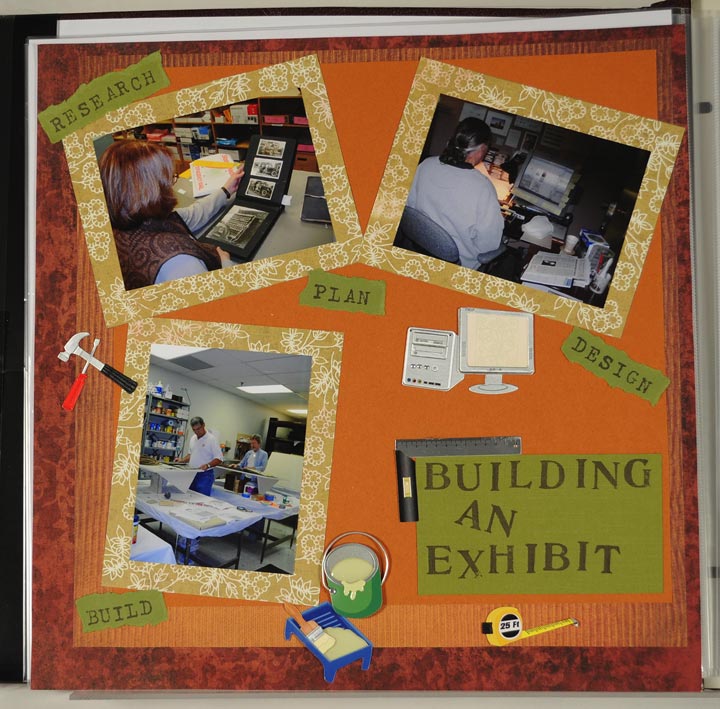Scrapbooks
While in the midst of school life you think its memories always will be fresh. Soon it will be over, the old associations gone, and the pleasant memories that you thought indelible will fade and fade, until a shadow here and there is all. They are but footprints of a few short years of fellowship. Some evening when your hair has turned to gray, you’ll draw your chair before the fireplace and follow back the road that’s now before you. The footprints gathered here will point the way. A program, a name and verse, a Kodak picture will each bring back its memories, made dearer by the intervening years.
From Footprints of Fellowship scrapbook, copyright 1913 Intre-Collegiate Press, Kansas City, Mo.

Unidentified girl looking at scrapbook in Doane College Dormitory, ca. 1920.
The practice of gathering mementos into a book can be traced at least as far back as medieval society when pilgrims to religious shrines collected souvenirs and devotional objects and occasionally attached them to pages of prayer books or Bibles. In the fifteenth century, volumes of quotations, prose, and poetry, called commonplace books, were compiled by men of letters and students as references to help in writing speeches and essays.
As printed material became more accessible, commonplace books began to incorporate clipped articles from newspapers and other sources, alongside the handwritten entries of their owners. The evolution of printing to include color images in the late eighteenth and early nineteenth centuries, plus the growing availability and affordability of paper made this type of volume accessible to and popular with a growing middle class. By 1835 the term scrapbook and the practice of compiling books of ephemera were common enough that “The Scrapbook,” a periodical promoting the hobby of making such volumes, was published.
Commercially produced scrapbooks were widely available by the 1820s. By the 1860s, new innovations in scrapbooks were being patented and creating them was a hobby enjoyed by men, women, and children of all social and economic backgrounds.
What Shall We Do Now? 500 Children’s Games and Pastimes by Dorothy Canfield and Others, 1907
Dorothy Canfield Fisher was born in 1870 in Lawrence, Kansas. Her father served as chancellor of the University of Nebraska from 1891 to 1895, and Dorothy met and became a lifelong friend of fellow student Willa Cather.

What Shall We Do Now? 500 Children’s Games and Pastimes
Making scrapbooks is always a pleasant and useful employment, whether for yourself or for children in hospitals or districts, and there was never so good an opportunity as now of getting interesting pictures. These you select from odd numbers of magazines, Christmas numbers, illustrated papers and advertisements. Scraps are very useful to fill up odd corners. In choosing pictures for your own scrapbook it is better to select only those that you really believe in and can find a reason for using, than to take everything that seems likely to fit. By choosing the pictures with this care you make the work more interesting and the book peculiarly your own.
Empty scrapbooks can be bought; or you can make one by taking (for a large one) an old business ledger, which some one whom you know is certain to be able to give you, or (for a small one) an ordinary old exercise book, and then cutting out every other page about half an inch from the stitching. This is to allow room for the extra thickness which the pictures will give to the book. Or you can sew sheets of brown paper together.
Willa Cather, Author
Willa Cather was born in Virginia in 1873 and moved with her family to Webster County, Nebraska, in 1883. She grew up in Red Cloud, and in 1891 moved to Lincoln to attend the University of Nebraska.
Following her graduation in 1895 Cather briefly wrote for a Lincoln newspaper before moving east to Pittsburgh to edit The Home Monthly. She moved on to become copy editor and music and drama critic for a Pittsburgh newspaper. She also taught English and Latin in Pittsburgh schools. In 1906, she moved to New York to become managing editor of McClure’s magazine.
In 1912, she resigned to devote all of her time to writing. Cather was the author of twelve novels, including the Pulitzer Prize-winning One of Ours. Six of these novels are set, at least in part, in the Nebraska of her youth.
Willa Cather died in 1947 in New York City.
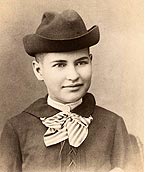
Willa Cather, about 1890. (RG2639.PH1-36)
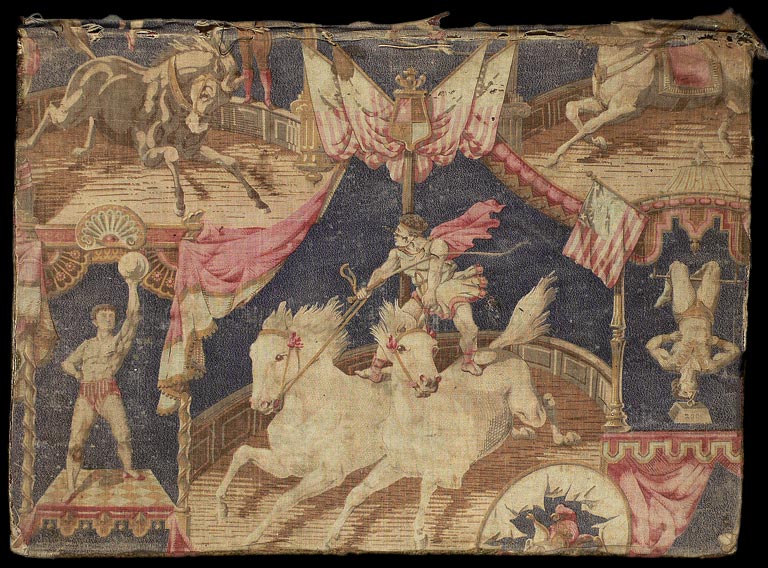

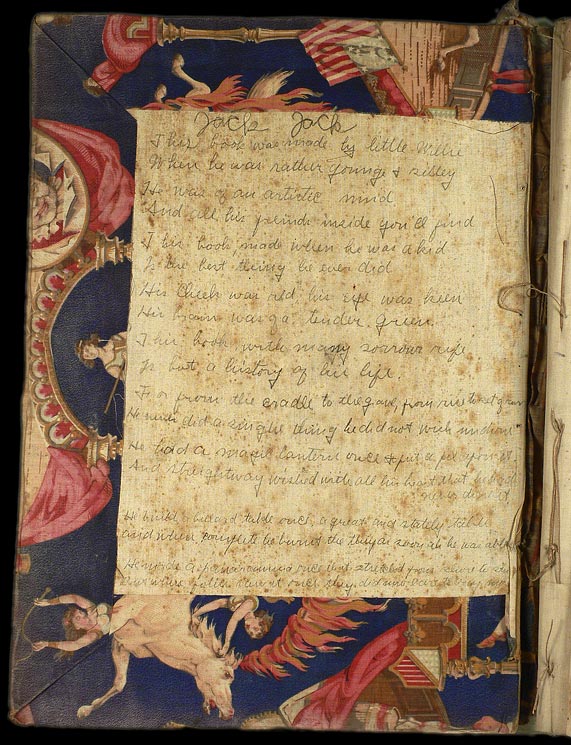
We know very little about the actual creation of this scrapbook. Willa Cather’s original verse on the inside front cover claims it as her own (as a young girl she often went by “Willie” rather than Willa).
The cover of the volume is a circus-themed fabric, and the pages are filled with advertising and Sunday School cards, some with notations in Cather’s handwriting.
![]() Complete copy of Willa Cather’s scrapbook.
Complete copy of Willa Cather’s scrapbook.
This book was made by little Willie
When he was rather young & silley
He was of an artistic mind
And all his freinds inside you’ll find
This book, made when he was a kid
Is the best thing he ever did
His cheek was red, his eye was keen
His brain was of a tender green.
This book, with many sorrows rife
Is but a history of his life.
For from the cradle to the grave, from rise to set of sun,
He never did a single thing he did not wish undone
He had a magic lantern once & put a pix upon it.
And straightway wished with all his heart that he had never done it.
He build a billard table once, a great and stately table
And when complete he burnt the thing as soon as he was able.
He made a panaramma once that stretched from shore to shore
But when folks saw it once they did not care to any more.
And once he stuffed a little bird which looked exceeding sweet
A ramrod stuck down through its neck & a spike in both its feet.
And so it was through all his life from early morn till night
What ‘er he did what ‘er he tried he never did it right.
What the cause was I could not tell unless that was it were,
He was to holy, good and pure to live among us here.
For troubles lay full thick & fast where’er his footstep trod
From the first moment he was borne till he went home to God.
His heart it was so good & true his soul so pure & good
That he would faint when’er he saw a little drop of blood
He killed a little kitten once, by accident of course
And wept untill his eyes were dim & till his throat was horse
He threw himself upon it’s grave and with his mighty love
He closed his lovely eyes & went up to his home above
When ‘er the evening’s damp & chilly
I hope you’ll pray for little Willie.
Willa Cather
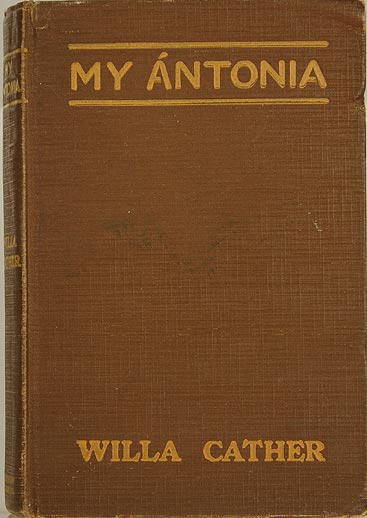
Cather’s childhood scrapbook is remarkably similar in appearance to the scrapbook that she describes her character Jim Burden creating in her novel My Antonia.
Grandmother took me into the ice-cold storeroom, where she had some bolts of gingham and sheeting. She cut squares of cotton cloth and we sewed them together into a book. We bound it between pasteboards, which I covered with brilliant calico, representing scenes from a circus. For two days I sat at the dining-room table, pasting this book full of pictures. We had files of those good old family magazines which used to publish coloured lithographs of popular paintings, and I was allowed to use some of these. On the white pages I grouped Sunday-School cards and advertising cards
My Antonia, Willa Cather
Cora Belle Hardy Calvert, Educator and Community Leader
Cora Belle Hardy was born in Gainesville, New York in 1861 and came to Lincoln, Nebraska with her family in 1865. Her father was an early mayor of Lincoln and was a candidate for governor on the prohibition ticket.
Cora attended the University of Nebraska and later worked as a teacher and principal in Lincoln public schools for twenty-seven years. She was an organizer of the YWCA, a world traveler, and a charter member of the Nebraska Art Association.
She died in 1940.

Cora Belle Hardy Calvert, 1927. (RG1998.PH1-1)

Scrapbooks are windows into the interests, hobbies, activities, and achievements of their makers.
In Cora’s scrapbook, the majority of the pages in the first half of the album are filled with newspaper clippings of poetry, the occasional print of a cat or kitten, and programs from commencements and literary presentations. Articles about her travels, about her family, and about her career as a teacher and school principal fill the last portion of the scrapbook.
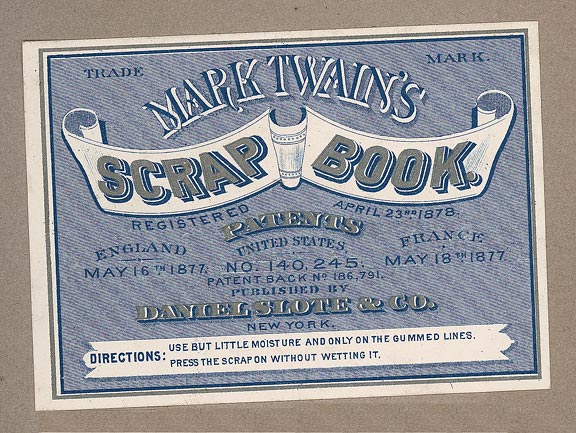
Cora’s scrapbook is a commercially produced volume patented by well-known author Mark Twain. Twain was an avid scrapbook keeper and in 1872 he created and began selling Mark Twain’s Patent Scrapbook.
This innovative volume was self-pasting with dots of adhesive already placed on the pages. When these dots were moistened, clippings would readily stick to them, simplifying the scrapbooking process — or so the advertising claimed.
Twain included the following testimony in some of his advertising.
Certificate
Messers, Slote, Woodman & Co.
I hereby certify that during many years I was afflicted with cramps in my limbs, indigestion, salt rheum, enlargement of the liver, & periodical attacks of inflammatory rheumatism complicated with St. Vitus’s dance, my sufferings being so great that for months at a time I was unable to stand upon my feet without assistance or speak the truth with it. But as soon as I had invented my Self-Pasting Scrap Book & begun to use it in my own family, all these infirmities disappeared.
In disseminating this universal healer among the world’s afflicted, you are doing a noble work, & I sincerely hop you will get your reward-partly in the sweet consciousness of doing good, but the bulk of it in cash.
Very Truly Yours,
Mark Twain.
Given under my hand this 10th day of February, A.D. 1878.
The St. Louis Post-Dispatch reported in June of 1885 that while he had made $200,000 from all of his other books published, Twain had earned a profit of $50,000 from his scrapbook alone.
Fenton B. Fleming, Businessman and Community Leader
Fenton Burn Fleming was born in Kansas in 1883, attended Kansas State College, and moved to Lincoln in 1903, where he married Margarett Royce in 1906. He operated a jewelry store and was mayor of Lincoln for two years. Fleming died in 1953.
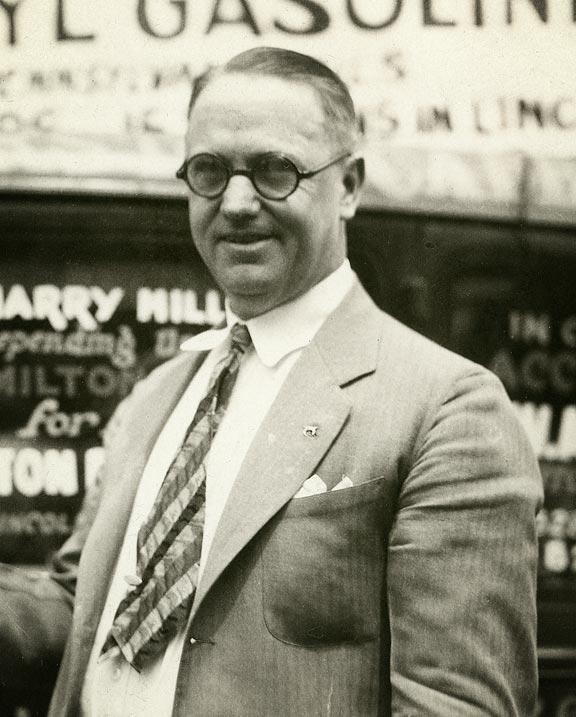
Fenton Fleming (RG3926.PH1-6)
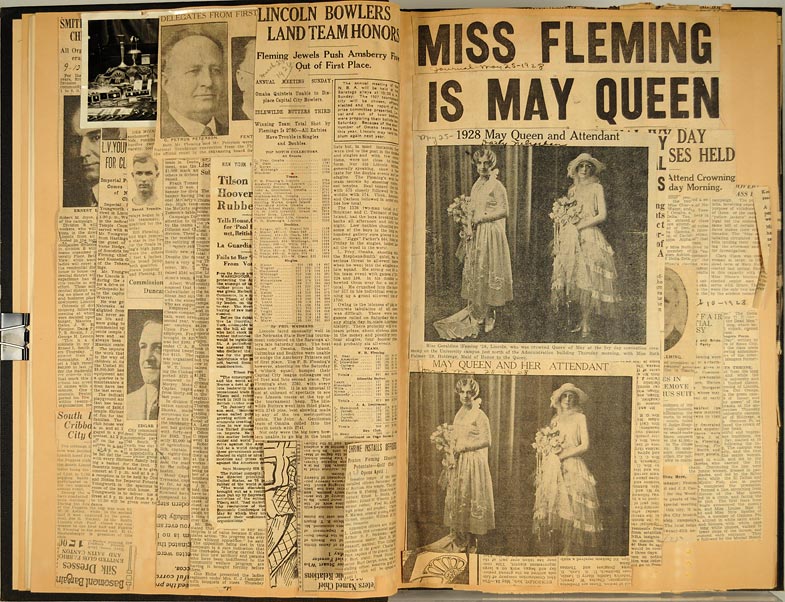
Fenton Fleming’s active business and political life is reflected in his scrapbooks, which are filled with newspaper clippings that document his activities. The scrapbooks he used were designed specifically to hold newspaper clippings and they, like the pages of Mark Twain’s scrapbooks, were prepared with adhesive that needed only to be moistened to adhere clippings to the page.
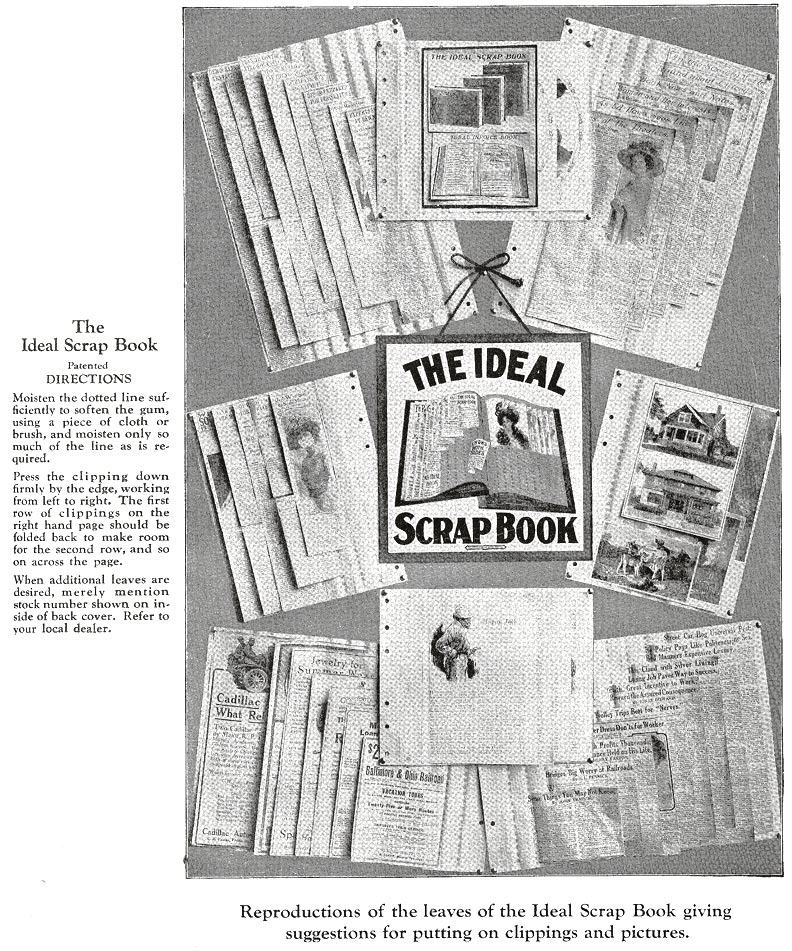
As this advertisement for these patented Ideal Scrap Books illustrates, the clippings were to be layered from the inside edge of the page to the outside edge, allowing for far more clippings to fit on a page than otherwise possible. Clearly, in this type of album, volume was far more important than aesthetics.
Myrtle Taake Soulier, Student
Two targeted audiences for commercial scrapbooks in the first quarter of the twentieth century were high school and college students. Albums were specifically designed to guide young people in capturing memories of friends, classmates, and the extra-curricular social activities that made their school days special.

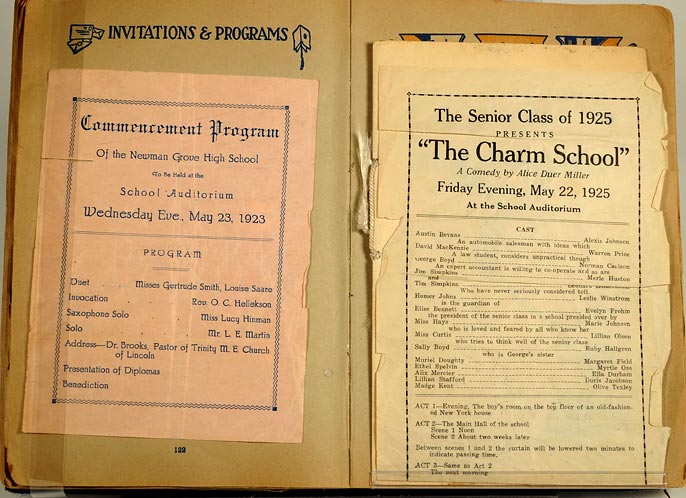
Myrtle Taake was born in 1907 in Madison County, Nebraska, and graduated from Newman Grove High School. She married Frank Soulier of rural Madison County and together they farmed before retiring to Tilden. Myrtle died in 2003.
Myrtle’s scrapbook, a commercially-produced volume called School-Girl Days, A Memory Book, was designed specifically for female high school students and organized to guide its owner to preserve all of the information that would later be important to her in remembering her school experience.
Verna Cort, Student
Verna M. Cort was born in Iowa in 1897. She graduated from Maryville (Missouri) High School in 1918 and received her teaching certificate from Doane College in Crete, Nebraska, in 1921. In 1922 she married Leonard Bosch of Maryville, Missouri. Verna Cort Bosch died in 1978.
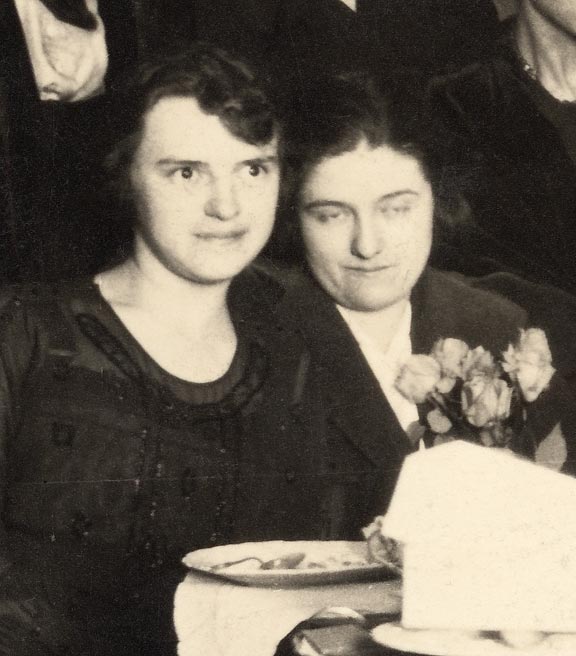
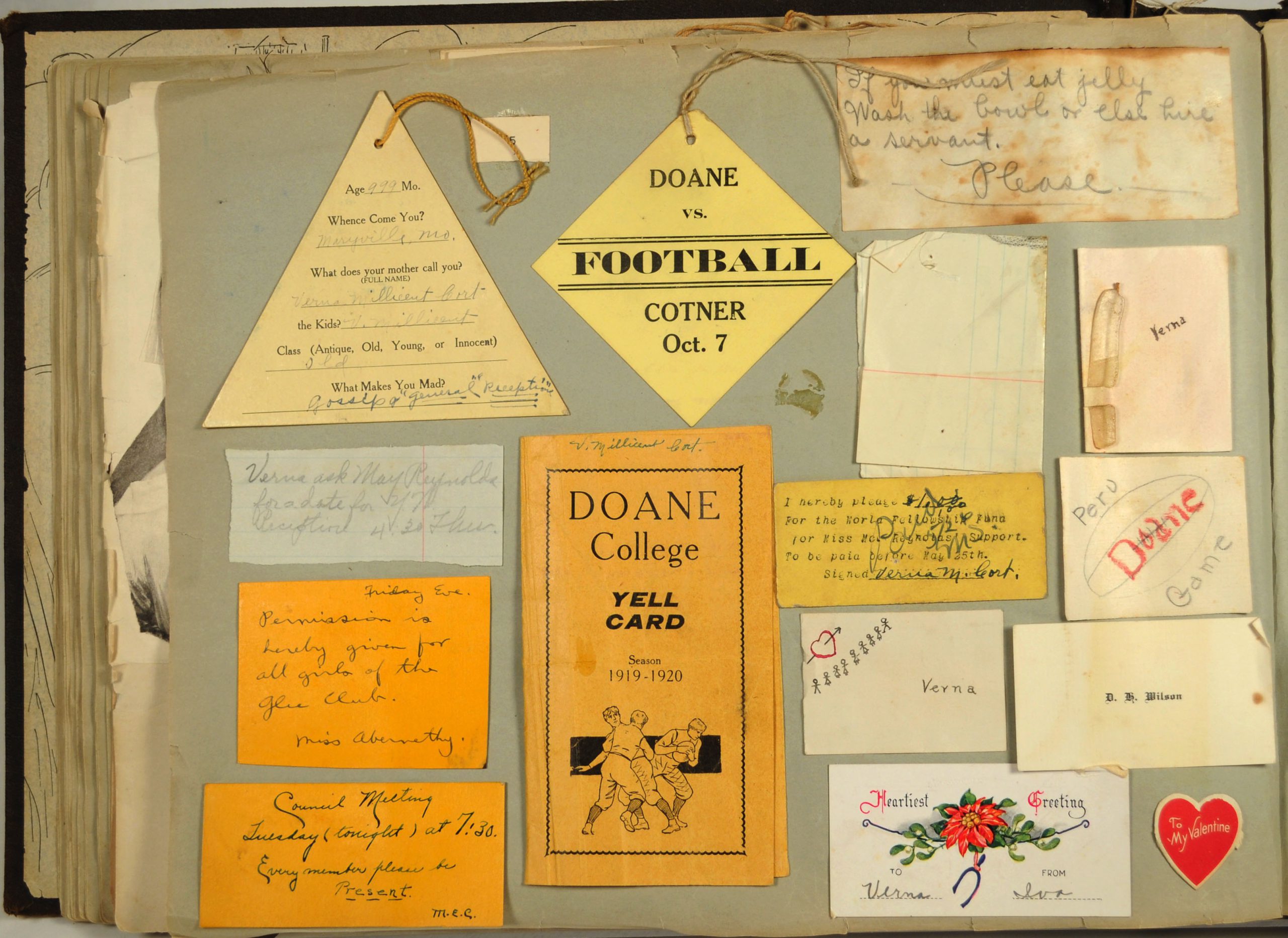
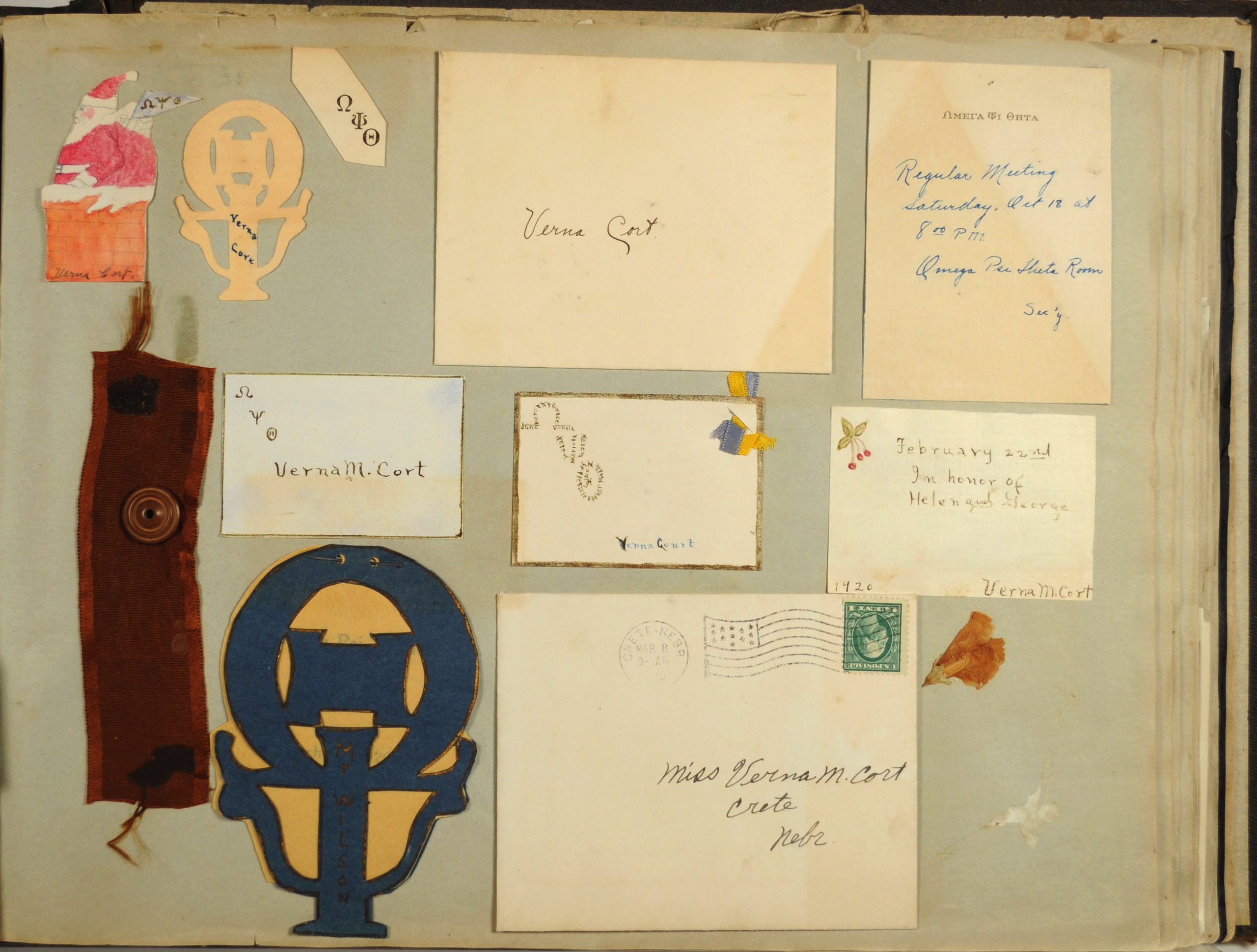
Verna’s Doane College scrapbook is a commercially produced volume made specifically for college students.
The cover is embossed in gold with Doane’s seal and Verna’s name. Pages in the scrapbook are printed with verses about preserving memories and with printed directions for gathering the materials that would presumably help the owner select those items that would help recall those memories.
Several pages provide space for friends to inscribe their name, home, birthday, and “a word or two or toast will do”. Other pages are dedicated to recording memories of college activities such as Inter-Collegiate Athletic Record; Theatres, Lectures and Entertainments; Classroom Boneheads; Social Gatherings; and Pleasure Jaunts.
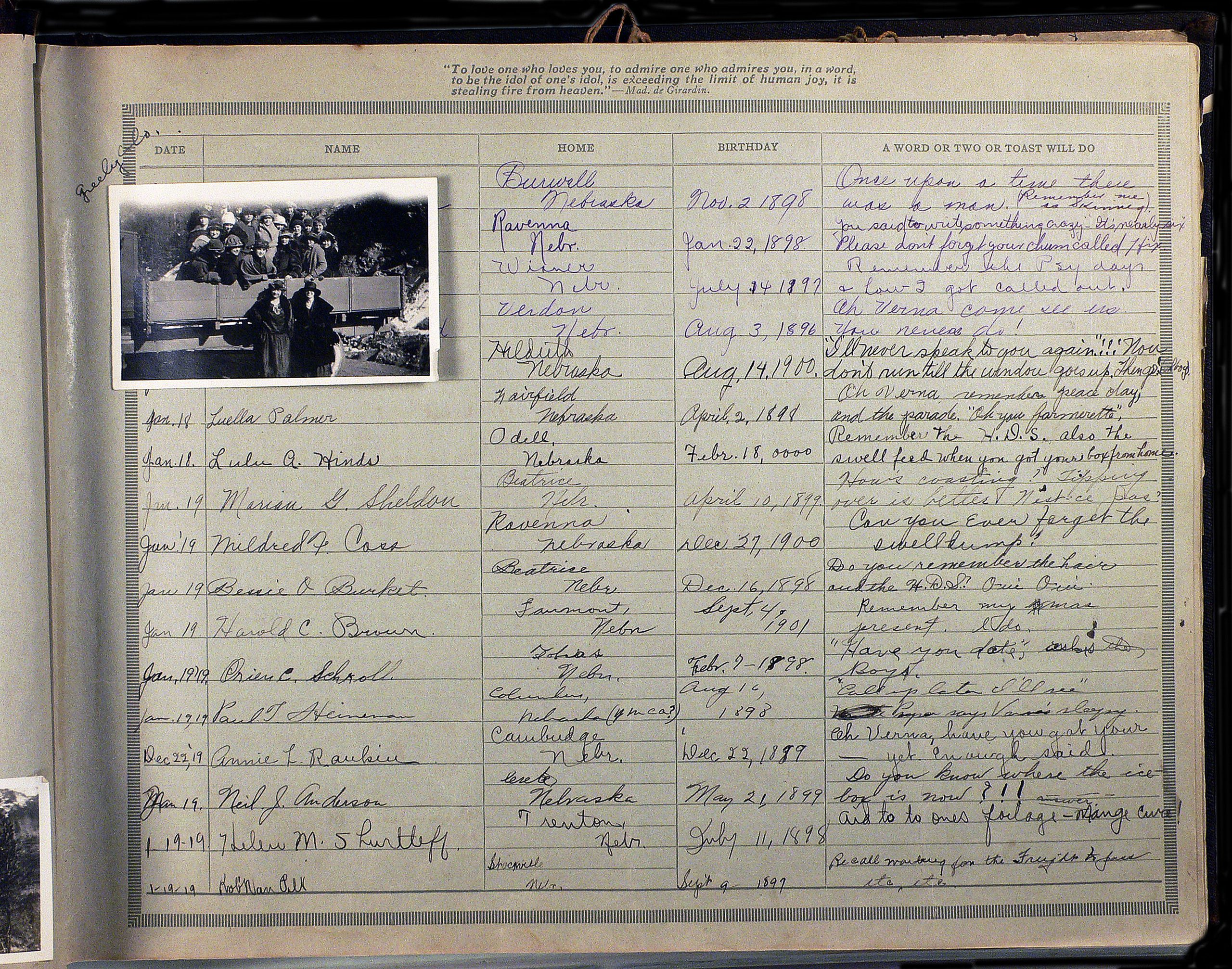

The majority of the pages are left blank for the book’s owner to fill as they wished with a few of the back pages covered with adhesive dots to which newspaper clippings could be attached. The book even took into account the inevitable delay in assembling the pages and included a pocket labeled “Use this Envelope to Preserve Material Until You Find Time to Insert it in Fellowship Book Carefully”
Most items that found their way onto these pages were mementos of happy times. But a few, like the postcard telling students that the dormitory quarantine during the 1918 flu epidemic was lifted, had to bring back more serious memories. Verna filled her scrapbook to overflowing, even to the point of pasting items on the inside covers and covering up some of the printed pages with photographs and mementos. It appears from her scrapbook that this was a young woman with a busy social life.
Martha Groves McKelvie, Movie Columnist
Martha Groves De Arnold was born in Missouri in 1886 and moved to Nebraska with her parents when she was five.
In 1903 she graduated from the Lincoln Conservatory of Music and married Samuel Roy McKelvie, a year later. He was a writer, lawyer, stock breeder, and served as governor of Nebraska from 1919 to 1923.
Martha McKelvie became one of Hollywood’s first movie columnists, interviewing stars such as Mary Pickford, William S. Hart, and Douglas Fairbanks. She also wrote movie scripts and plays.
From 1931 through 1953, the McKelvies owned and lived on a ranch in Cherry County, publishing a magazine titled By the Way. They sold the ranch in 1953 and retired to Arizona where in 1959 Martha published the first of twenty-four books that she would eventually write. She died in 1976.
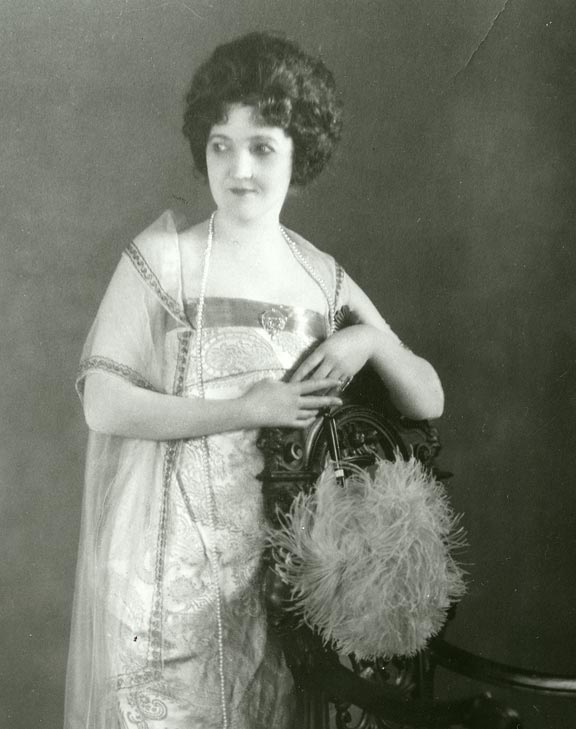
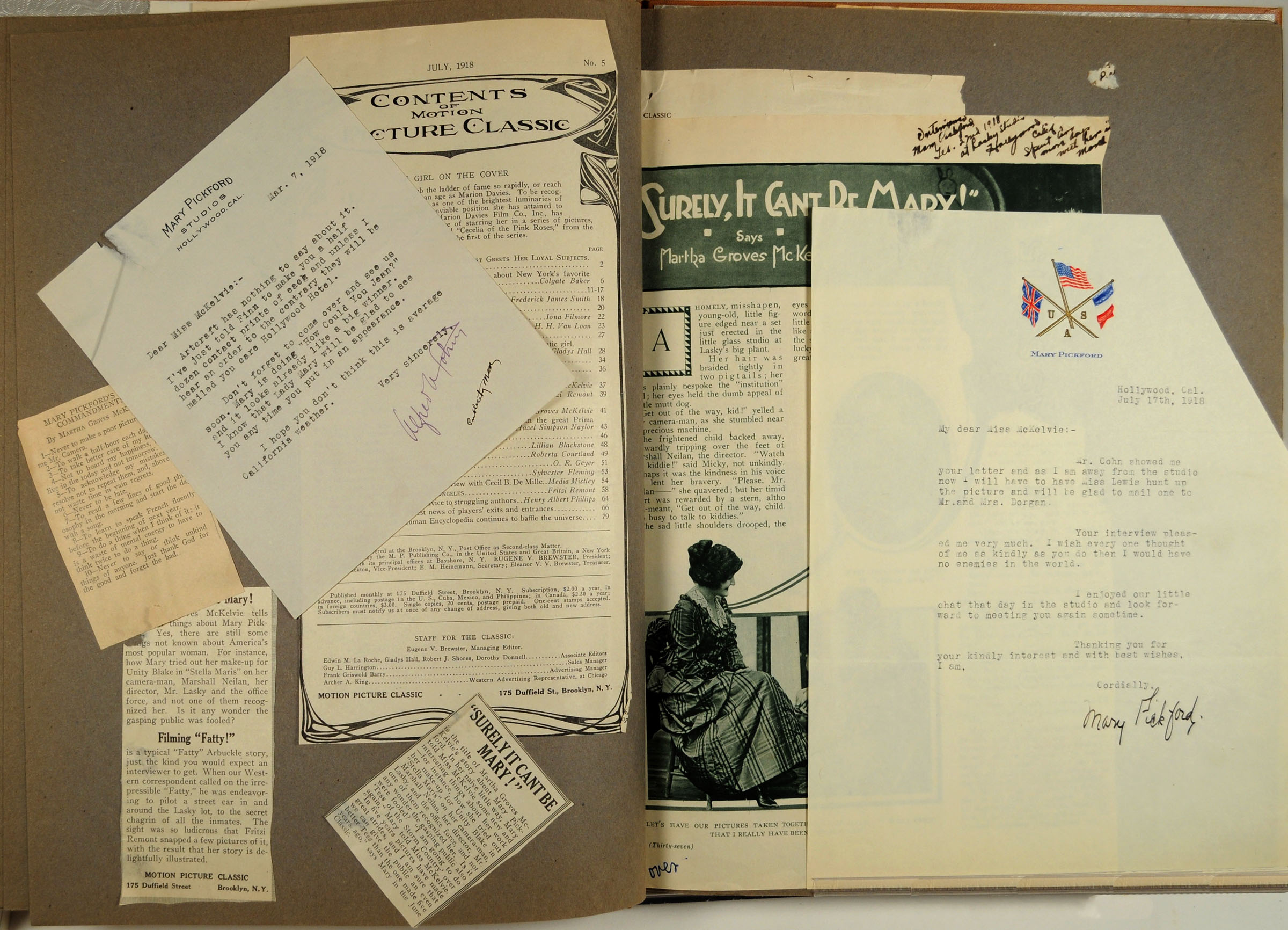
The citizens of Nebraska knew Martha McKelvie best as the state’s First Lady from 1919 to 1923, but she held a much more glamorous career as an early film columnist for Motion Picture Classic, rubbing elbows with film stars. It is this aspect of her life that she preserved in this scrapbook.
Martha’s interview with Mary Pickford appeared in the July 1918 issue of Motion Picture Classic and, as she did with many of her other interviews and articles with movie stars, Martha pasted a copy of the article and with other items relating to the interview, in her scrapbook. For this article, that included a thank you letter from Mary Pickford herself, which McKelvie slipped between the pages of the volume.
Emogene Heston Moor, Women’s Army Corp
Emogene Heston Moor was born in Ohiowa, Nebraska, in 1902. She graduated from Ohiowa High School and received both a B.A. and an M.A. from the University of Nebraska.
She joined the United States Women’s Army Corps in 1943, underwent basic training at Fort Des Moines, Iowa. She was stationed at Fort Buckley, Colorado, and in July 1945 she shipped overseas for a one year stint in Berlin.
Following her discharge, she operated a bookstore and taught in the University of Nebraska extension division’s high school. Following her retirement, she was active in local organizations, in the Democratic Party, and was named a “groundbreaker” by the Lincoln-Lancaster Commission on the Status of Women. She died in 1989.
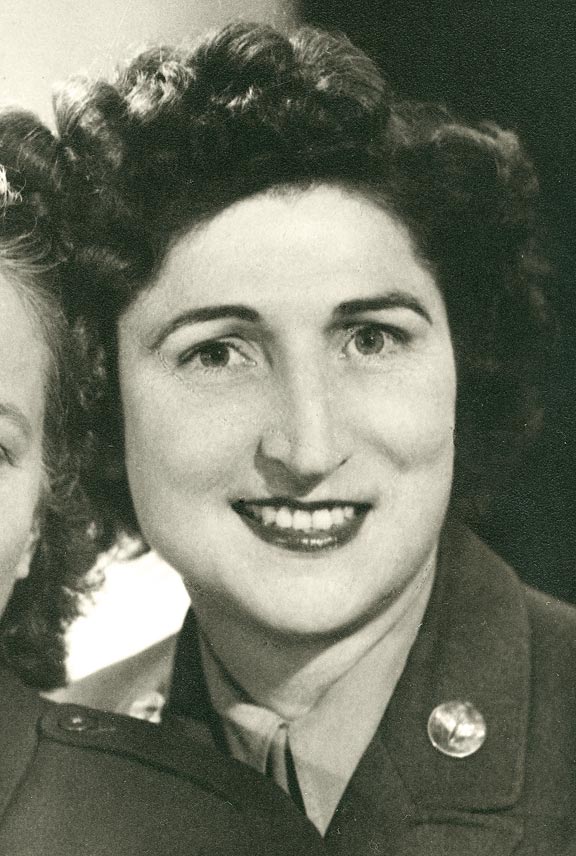
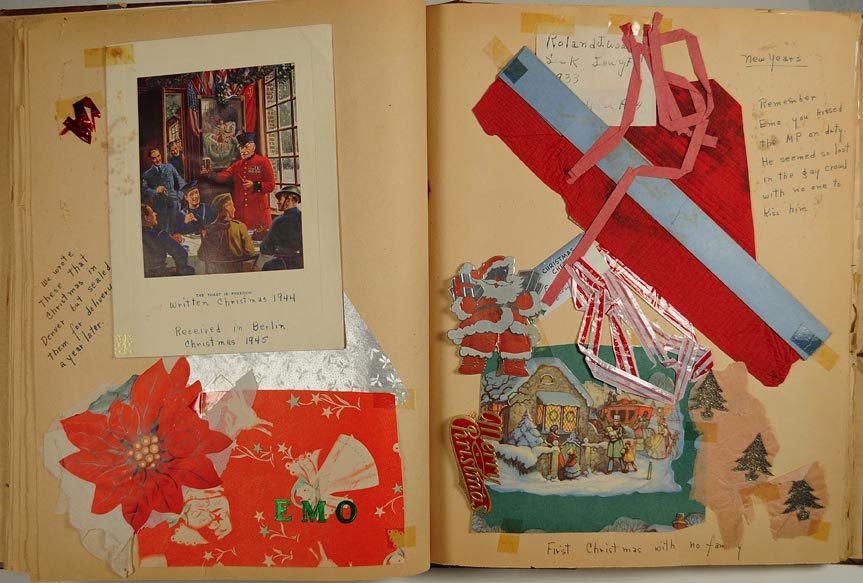
In service at the end of World War II, Emogene Moor found herself stationed overseas as part of the U.S. occupation force. She took advantage of leave time to travel Europe and her scrapbook is full of photographs, souvenir ticket stubs, newspaper clippings, cards, and other memorabilia from those travels. Her scrapbook pages are also frequently labeled with short, enigmatic references to things that had happened to her and her friends.
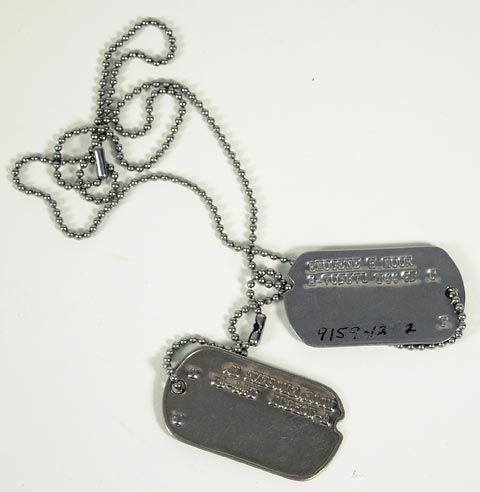
Emogene Moor’s dog tags, which she wore during her service in the United States Women’s Army Corps.
Scapbooking Today
We trace the current interest in scrapbooking to the work of Marielen Christensen who displayed her fifty family scrapbooks at the 1980 World Conference on Records in Salt Lake City. The next year, she published a how-to book, Keeping Memories Alive, with her husband, A.J. Today, scrapbooking is the fastest growing sector of the craft and hobby industry. In fact, a 2005 survey showed that 29 percent of U.S. households have tried scrapbooking.
Today’s scrapbooks are a far cry from the reused or homemade books of the past. Frequently designed around clear themes, these books rely heavily on commercially produced embellishments to emphasize and enhance the photographs and mementos of their creators. While these scrapbooks may lack some of the spontaneity of earlier forms, they often provide better documentation for, and better long-term preservation of the material adhered to their pages.
